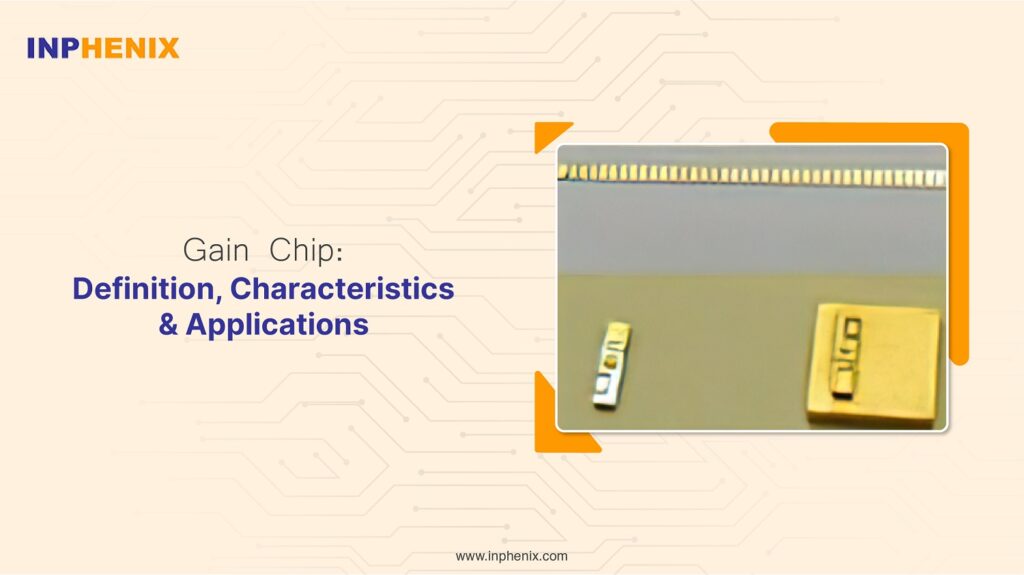
The new lasers open the way for the integration of optical and electrical components on gain chips, a breakthrough that might enhance computing speeds and data transmission rates considerably. Optical communications, spectroscopic methods, and frequency metrology have all been made possible by tunable lasers with small spectral linewidths.
Gain chips are semiconductor optical devices used in external cavity laser diodes as the optical gain medium. It is used as a TLS (Tunable Light Source) with a wavelength selection filter. Due to the nature of the technology, the semiconductor laser source is an ideal contender, since it offers the advantages of size, weight, and power, as well as cost and production scale.
In this blog, We have covered all of the significant aspects of gain chips. So let’s get started!

A gain chip is an essential part of the development of a tunable diode laser or a high-stability external cavity diode laser. It is used as a tunable light source with a frequency selection filter, such as a diffraction grating, to alter the oscillation wavelength.
Gain chips are similar to laser diode chips except that they include a thick anti-reflective coating on one or both faces, which considerably reduces or eliminates self-lacing. The diffraction grating is light of the desired wavelength reflected back along the incident beam. The grating is rotated to scan the wavelength. The output laser beam can be a zero-order diffracted beam.
Optical access on one side gain-chip is an excellent component for use in systems where the output power is uncoupled from the external cavity. It is included with the to-can package.
Type A:
A typical straight stripe to the facets with strong reflecting HR and extensive antireflecting AR coatings distinguishes the type A gain chip. This is the most cost-effective external cavity diode laser, with a high NA aspheric lens that offers excellent coupling to the external cavity and the back. This type of gain chip has relatively low gain spectral ripple removal compared to other types.
Type B:
A curving stripe with normal side HR and thick AR coating on the sloping side distinguishes the Type B gain chip. It provides extremely low reflection, allowing self-lasing to be suppressed and gain ripples to output beam distortion. This makes collimation difficult and affects back coupling efficiency.
Optical access on both sides Gain-chips can be utilized in optical amplification schemes or in techniques that allow for direct power outcoupling from the Gain-chip.
Type C:
This type of gain chip features a curved stripe and deep AR coating, whereas, the normal side has a few percent reflections. This design provides a high output power and a decent output beam based on the system setup and desired output power. The wavelength selecting feedback must be on the angled side, while the output power must be on the normal side.
Type D:
Type D gain chip has a tilted stripe on both sides with a deep AR and is commonly used for complex optical systems to fulfill high-reliability requirements. The ISO verifies that production is based on rigorous design, fabrication, and testing, all of which are supported by test results.
A gain chip is utilized as a laser in an external cavity (EC) tunable laser configuration and has broadly tunable lasers at various wavelengths due to their active region design, cavity length, and essential performance figures. It is used in the telecom sector as a TLS that can alter the oscillation wavelength using a diffraction grating.
Let’s take a look at some of the most fascinating applications of gain chips in a brief.
A. As an External Cavity Type TLS :
In an external cavity laser diode, the gain medium is a resonant mirror on the outside of the semiconductor component. In order to regulate the oscillation frequency, a diffraction grating can be used.
B. As a Silicon Photonics Tunable Light Source:
In communication networks with speeds reaching 100 Gbps, coherent optical fiber communications with ultra-high-speed digital signal processing are used. This has emphasized silicon photonics technology, which employs a silicon chip that contains an optical waveguide, an optical modulator, and a wavelength filter. The gain medium in silicon photonics is a Reflective SOA (RSOA) gain chip.
In addition, while choosing the gain chip, make sure you take care of the following criteria:
All these factors are very critical when choosing the perfect gain chips. Make sure, you take note of each one.
Gain chips are designed to give strong optical gain over a wide wavelength range. In an external cavity laser system, It serves as the laser gain source. It comes in chip or submount form, with high reflectivity (HR) coating on the standard rear facet and a low reflectivity anti-reflecting (AR) coating on the tilted front facet.
Let’s take a look at some key features of the gain chip:
As this blog has shown, the gain chip is a significant component in lasers. We’ve covered everything you need to know about it, its components, and its features with its applications. To know the advanced technical details of it, check our product page.
Inphenix develops and manufactures lasers and light sources for use in cutting-edge medical, telecommunications, sensing, and measurement applications. You can contact us for additional information about our products.
